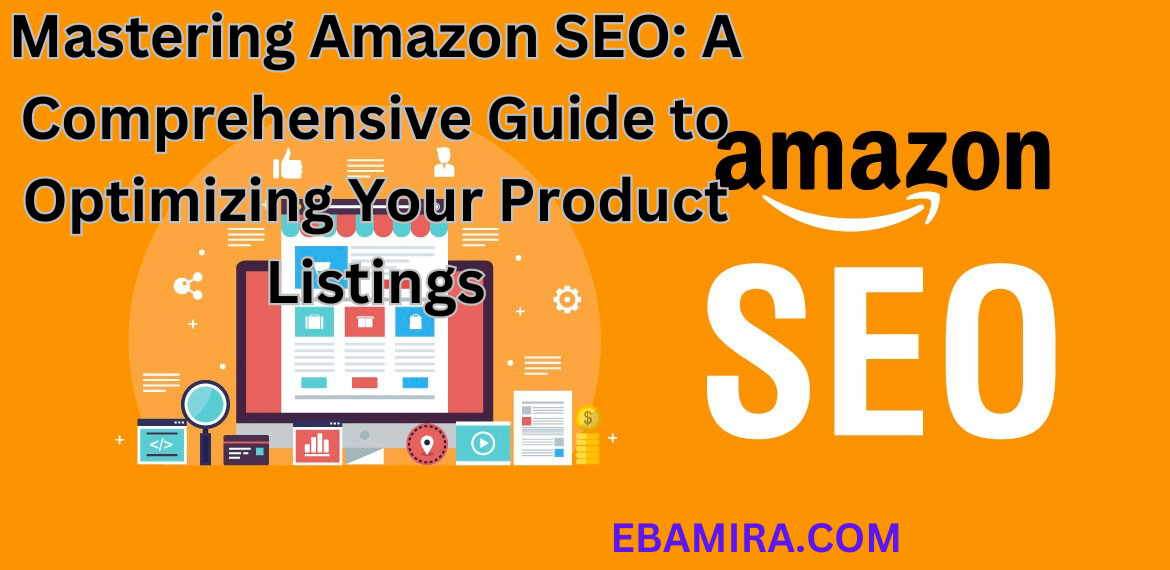Mastering Amazon SEO: A Comprehensive Guide to Optimizing Your Product Listings
In the competitive landscape of e-commerce, mastering Amazon SEO (Search Engine Optimization) is imperative for any seller aiming to stand out and drive sales. With millions of products available on the platform, ensuring your listings are optimized for visibility and relevance can make all the difference in attracting customers and achieving success. In this comprehensive guide, we will delve into the intricacies of Amazon SEO and provide actionable strategies to optimize your product listings effectively.
Understanding Amazon’s Search Algorithm
Before diving into optimization techniques, it’s crucial to comprehend how Amazon’s search algorithm operates. Unlike traditional search engines like Google, Amazon’s primary goal is to facilitate transactions rather than merely providing information. Therefore, its algorithm prioritizes factors that contribute to sales, such as relevance, conversion rate, and customer satisfaction.
- Relevance: Amazon aims to match search queries with the most relevant products. Keywords play a significant role in determining relevance, so it’s essential to conduct thorough keyword research and incorporate relevant terms into your product listings.
- Conversion Rate: The rate at which users purchase a product after viewing it is a key metric for Amazon’s algorithm. High-converting listings are more likely to rank higher in search results. Optimizing product titles, images, and descriptions to encourage conversions is crucial.
- Customer Satisfaction: Factors such as positive reviews, seller reputation, and fulfillment methods influence customer satisfaction. Providing excellent customer service and delivering high-quality products can lead to better rankings and increased visibility.
Optimizing Your Product Listings
Now that we have a basic understanding of Amazon’s search algorithm, let’s explore how to optimize your product listings effectively.
1. Keyword Research and Optimization
- Utilize Keyword Tools: Use Amazon’s own search bar, as well as third-party keyword research tools, to identify relevant keywords with high search volume.
- Long-Tail Keywords: Target specific, long-tail keywords that reflect the intent of potential customers. These keywords often have lower competition and higher conversion rates.
- Strategic Placement: Incorporate primary keywords into your product title, bullet points, product description, and backend search terms. However, avoid keyword stuffing, as it can negatively impact readability and conversion rates.
2. Compelling Product Titles
- Clarity and Relevance: Craft clear and descriptive titles that accurately represent your product. Include important details such as brand name, product type, key features, and size/color variations.
- Keyword Placement: Place primary keywords towards the beginning of the title for maximum visibility. However, prioritize readability and avoid keyword stuffing.
- Capitalization and Formatting: Follow Amazon’s guidelines for title formatting, which typically involve capitalizing the first letter of each word and avoiding excessive punctuation or special characters.
3. High-Quality Product Images
- Main Image: Choose a high-resolution main image that showcases your product prominently. Follow Amazon’s image guidelines regarding size, background, and content.
- Additional Images: Include multiple images from different angles to provide customers with a comprehensive view of your product. Highlight key features and benefits through imagery.
- Infographics and Lifestyle Images: Incorporate infographics or lifestyle images to demonstrate product usage and convey its value to potential customers.
4. Compelling Product Descriptions
- Feature-Driven: Highlight the unique features and benefits of your product in the description. Focus on addressing customer pain points and explaining how your product solves them.
- Use Bulleted Lists: Break down information into easy-to-read bullet points for better readability. Highlight key specifications, uses, and benefits.
- Include Social Proof: Incorporate positive reviews and testimonials into your product description to build trust and credibility with potential buyers.
5. Enhanced Brand Content (EBC)
- Tell Your Brand Story: Utilize EBC to showcase your brand’s unique story, values, and mission. Use engaging visuals and compelling copy to connect with customers on a deeper level.
- Highlight Product Features: Use EBC to provide in-depth information about your product’s features and benefits. Leverage multimedia elements such as videos and interactive content to enhance the user experience.
- Drive Conversions: Use EBC to create a persuasive narrative that convinces customers to make a purchase. Highlight special offers, promotions, and unique selling points to incentivize conversions.
6. A/B Testing and Iteration
- Continuous Improvement: Implement A/B testing to compare different elements of your product listings, such as titles, images, and descriptions. Analyze the results and iterate based on data-driven insights to continually optimize your listings for better performance.
- Optimization Tools: Leverage Amazon’s built-in tools and third-party software to track key metrics, monitor performance, and identify areas for improvement. Tools such as Amazon’s Seller Central dashboard, sponsored ads, and analytics platforms can provide valuable insights into customer behavior and preferences.
7. Monitor Competitor Activity
- Competitor Analysis: Keep an eye on your competitors’ product listings to identify trends, strategies, and opportunities for differentiation. Analyze their titles, keywords, images, and pricing strategies to stay competitive and adjust your approach accordingly.
- Differentiation: Identify unique selling points and value propositions that set your products apart from competitors. Highlight these aspects in your listings to attract customers and stand out in a crowded marketplace.
8. Optimize for Mobile
- Mobile-Friendly Design: With a growing number of shoppers using mobile devices to browse and purchase products on Amazon, it’s essential to ensure that your product listings are optimized for mobile viewing. Choose responsive design elements, concise content, and fast-loading images to enhance the mobile shopping experience.
- Mobile SEO: Pay attention to mobile-specific SEO factors, such as mobile-friendly URLs, meta tags, and structured data markup. Optimizing for mobile search can improve your visibility and rankings on Amazon’s mobile app and mobile website.
9. Utilize Amazon Advertising
- Sponsored Products: Consider investing in sponsored product ads to increase visibility and drive traffic to your product listings. Target relevant keywords and optimize ad copy to maximize click-through rates and conversions.
- Amazon DSP: Explore advanced advertising options such as Amazon Demand-Side Platform (DSP) to reach target audiences across Amazon-owned properties and third-party websites. Leverage audience targeting, retargeting, and dynamic creative optimization to maximize ROI and sales.
10. Stay Compliant with Amazon Guidelines
- Policy Compliance: Familiarize yourself with Amazon’s policies and guidelines regarding product listings, keywords, images, and advertising practices. Ensure that your listings adhere to these guidelines to avoid penalties, account suspension, or removal of your products from the platform.
- Stay Updated: Regularly check for updates and changes to Amazon’s policies and algorithms. Keep abreast of industry news, best practices, and emerging trends in e-commerce and SEO to maintain a competitive edge and adapt your strategies accordingly.
Conclusion
Optimizing your product listings for Amazon SEO is a multifaceted process that requires careful planning, execution, and ongoing optimization. By following the strategies outlined in this guide and staying proactive in monitoring performance, analyzing data, and adapting to changes, you can improve the visibility, relevance, and conversion rate of your listings, ultimately driving sales and achieving success on the world’s largest e-commerce platform. Remember that Amazon SEO is not a one-time effort but a continuous journey of refinement and adaptation to evolving consumer preferences, market dynamics, and algorithmic updates. With dedication, persistence, and strategic execution, you can optimize your product listings effectively and position your brand for long-term success on Amazon.






